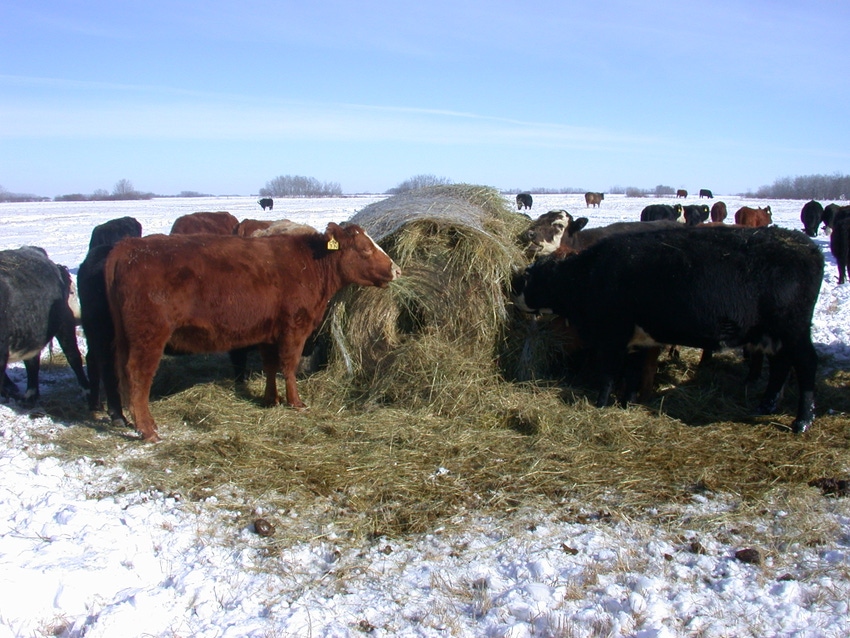Bale grazing: An option for easier winter feeding
Let your cows feed themselves while improving soil fertility.
November 12, 2020

A growing number of cattlemen are cutting winter feed costs and making winter feeding easier; they have opted to let the cows feed themselves. Bale grazing—leaving big round bales in the field where they harvested or hauling bales to a certain pasture to set out in rows for strip grazing in winter—can be more cost-effective than hauling hay to cattle daily.
This also adds fertility to those fields or pastures because it concentrates the cows temporarily in the areas where they are eating bales. The manure deposits are gradually moved across the field as the cows go to the next row of bales
Kevin Sedivec, professor of animal science at North Dakota State University, was involved with a three-year study with several producers in central North Dakota a few years ago, to see if bale grazing increases forage production. The spot where each bale had been set was marked, and later assessed for a certain distance around each bale.
“The first summer after the bales were eaten, we looked at forage production and forage quality. There was a 50% increase in forage production in the area where a bale had been. Additionally, forage quality was almost doubled in crude protein compared with control areas in the same field, (same soil type, same vegetation, but without the bale grazing),” he says.
The plants in the control areas had about 9.5% protein value. “Where we bale grazed, crude protein content in the forage the following spring was almost 16% protein, and a higher palatable feed; the cows were seeking it out,” says Sedivec. There was a 50% increase in forage production 15 feet from the bale center, where the manure and urine was deposited by the cattle eating on the bale.
“The second summer after bale grazing, we saw increased production throughout the whole profile—from zero (center of where the bale had been) to 15 feet. It ranged from 130% of normal (a 30% increase) to as high as 180% (80% increase).
Improving plant nutrition
“We also saw an increase in phosphorus and potassium content of the grass for two years following bale grazing. This was also a plus, since our Northern Plains are usually short on phosphorus; it is the most limiting mineral in the nutrients for our native grasses,” he says.
Various nutrients were deposited on the soil by the fecal matter and urine and the grass was picking it up. “Instead of going into the soil profile and deposited down-slope, the grass was increasing in quality via those nutrients, but we did see a four-fold increase in nitrogen in the soil,” says Sedivec.
Some producers feel that concentrating the cattle around the bales would damage the soil, possibly beating out the plants or causing soil compaction. “We checked for these issues, and looked for evidence of compaction and found none. Even if there is some compaction at the time of grazing, the freeze-thaw cycles here on the Northern Plains would take it back out,” he says.
“As long as the cows are not bale grazing after the first of April—when the grass is trying to grow, and when the frost has already come out—you won’t see compaction. If a person is bale grazing later in the spring, you don’t get the benefit of the freeze-thaw cycle because the ground has already thawed,” he says.
He’s not sure how this would work in areas farther south where there isn’t much frost in the winter to counteract compaction. There may also be some variability in overall results with climate differences, but in general the production, fertility and quality will be increased, without impacting animal performance.
Different management = different results
“In our study, however, every producer’s management was different. One rancher supplemented his cows while they were bale grazing, and the other three did not. One of them made his cows clean up the old bales before they went to the new ones. Another rancher did not push his cows at all and ended up with too much litter. He actually lost (forage) production the first year after bale grazing because there was so much litter that the grass couldn’t grow up through it and production was cut in half.”
Yet the next year, during a drought, those areas had tremendous production because all that litter held moisture. In the second growing season after the bale grazing, that producer actually had the greatest increase in forage production.
“The litter had broken down by then and was still holding moisture. That rancher grew more grass in those areas than he did in other areas of the field,” says Sedivec. In subsequent years, the litter is a big plus, but if there is too much the first year it can cut down production.
“The fourth rancher did it about right. He’s been bale grazing a long time and uses this as a tool to increase forage production on many of his fields and pastures. He grazes the bales fairly hard but leaves some litter.
“He gets increased production the first, second, and third year afterward, whereas the producers who leave too much litter see a decline in production the first year. You give up a year of production if you leave too much; it’s better to make the cows clean up more of it. Yet each producer has different goals,” explains Sedivec.
Smith Thomas is a rancher and freelance writer based in Salmon, Idaho. The opinions of the author are not necessarily those of beefmagazine.com or Farm Progress.
About the Author(s)
You May Also Like


.png?width=300&auto=webp&quality=80&disable=upscale)
